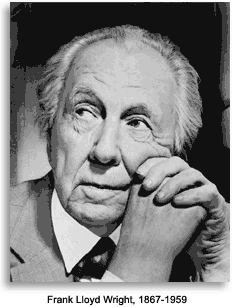Without formal training in architecture, Frank Lloyd Wright nevertheless established himself as the most influential American architect of the 20th century. At an early stage in his career, he adopted the concept that "form follows function," which led him to design some of the most innovative designs for structures that ranged from modest homes to the Guggenheim Museum in New York City.
 Wright's parents were William Cary Wright and Anna Lloyd Jones Wright, who traced their ancestry to Wales. Born Frank Lincoln Wright on June 8, 1867, he changed his middle name from Lincoln to Lloyd after his parents divorced. For a few semesters, Wright attended the University of Wisconsin and took civil engineering and drafting classes. In 1887, without completing a degree, he took a train to Chicago, Illinois, and found employment as a tracer with Joseph Lyman Silsbee for eight dollars a week. His first commissioned work was the Hillside Home School, which was built for Wright’s aunts in 1888 near Spring Green, Wisconsin.
Wright's parents were William Cary Wright and Anna Lloyd Jones Wright, who traced their ancestry to Wales. Born Frank Lincoln Wright on June 8, 1867, he changed his middle name from Lincoln to Lloyd after his parents divorced. For a few semesters, Wright attended the University of Wisconsin and took civil engineering and drafting classes. In 1887, without completing a degree, he took a train to Chicago, Illinois, and found employment as a tracer with Joseph Lyman Silsbee for eight dollars a week. His first commissioned work was the Hillside Home School, which was built for Wright’s aunts in 1888 near Spring Green, Wisconsin.
After about a year, Wright obtained a better job as a draftsman for Adler and Sullivan, a prominent Chicago architectural firm then at the forefront of architectural design. Wright would later refer to Louis Sullivan as his Lieber Meister, which means "beloved master,” and acknowledge Sullivan alone as an influence on his work.
In 1889, Wright married Catherine Lee Clark Tobin — the first of three wives — with whom he had six children. With $5,000 borrowed from Sullivan, he purchased a lot in Oak Park, in an affluent suburb west of downtown Chicago, and built his first home.
Wright stayed with Adler and Sullivan until 1893, when his growing number of independent commissions convinced his employers that he was "moonlighting" and terminated him, based on company policy. Wright rebounded by opening his own firm, first operating from the Adler and Sullivan-designed Schiller Building, then the Steinway Building, and finally in 1898, a studio at his home in Oak Park.
Forty-nine buildings were constructed from Wright's designs during his first eight years as an independent architect. During that time, he began to develop what is known as the Prairie Style of architecture, named after a house he designed for a Ladies Home Journal article in 1901. He also opened the Prairie School of Architecture, which focused on single-family homes for middle-class families. His early homes often were single story built around a central chimney, with rooms freely interconnected, windows in vertical clusters, and wide, overhanging eaves. His architectural designs are often associated with the Arts and Crafts Movement.
 Wright did not limit himself to architecture. The 1906 Robie House in Chicago, for example, was not only built by him but contained a number of pieces of furniture that he designed. Regarding architectural interiors, he said that the "reality of a building is not the container but the space within." Such was the impact of Wright's designs that furniture makers even today are producing items based on them.
Wright did not limit himself to architecture. The 1906 Robie House in Chicago, for example, was not only built by him but contained a number of pieces of furniture that he designed. Regarding architectural interiors, he said that the "reality of a building is not the container but the space within." Such was the impact of Wright's designs that furniture makers even today are producing items based on them.
In 1909, Wright left his wife and traveled to Germany with Margaret “Mamah” Cheney, the wife of a neighbor and client. After nearly two years in Europe, the couple returned to the United States. Wright closed his Oak Park studio and opened an office in Orchestra Hall in Chicago. He also began to work on a home for himself and Mamah on 200 acres near Spring Hill, Wisconsin, which his mother had inherited. He named the house "Taliesin," which means "shining brow" in Welsh.
Wright divided his time between his Chicago office and Taliesin until August 15, 1914, when his chef became deranged, set fire to Taliesin, and murdered Cheney, two of her children, and two other people. Wright was devastated, but continued to work. He completed the Midway Garden commission in Chicago and launched into the rebuilding of Taliesin.
Following the tragedy at Taliesin, Wright received a letter of condolence from a sculptress named Miriam Noel. A romance soon bloomed and Wright asked her to move in with him at Taliesin, even though his first wife refused to give him a divorce. In 1916, Wright took Noel to Tokyo, Japan, so that he could oversee the construction of the Imperial Hotel, a task that was his primary occupation for the following six years. Upon their return in 1922, he learned that Tobin had agreed to a divorce. Free at last after more than a decade of separation, he married mentally disturbed Noel in November 1923, but they separated in March 1924 and divorced in 1928.
While still married to Noel, Wright had encountered a young Yugoslav, Olga Milanoff Hinzenberg, who was 33 years his junior, married but separated, and the mother of a young daughter Svetlana. In February, 1925, Wright invited Olgivanna, as she was known, along with her daughter, to live with him at Taliesin. Two months later, she was divorced and by the end of the year, she bore him a daughter, Iovanna. About three years later, the couple was officially married.
 With the coming of the Great Depression, architectural commissions became scarce. Wright turned first to writing and lecturing, and then in 1932, he opened the Taliesin Fellowship, an architectural school for 30 students at Taliesin. One of his students convinced his father that he should let Wright design his home. The result was Wright's residential masterpiece, Fallingwater, the house built over a waterfall.
With the coming of the Great Depression, architectural commissions became scarce. Wright turned first to writing and lecturing, and then in 1932, he opened the Taliesin Fellowship, an architectural school for 30 students at Taliesin. One of his students convinced his father that he should let Wright design his home. The result was Wright's residential masterpiece, Fallingwater, the house built over a waterfall.
In 1929, Wright spent time in Arizona working on projects. He returned in 1938 with his apprentices to build Taliesin West, a home on 800 acres he had purchased from the government. Wright and his fellowship were now able to alternate between Arizona and Wisconsin, depending on the season.
Age had no evident effect on Wright's productivity. Following World War II, he received commissions for 270 houses, as well as the Guggenheim Museum in New York City and the Marin County Civic Center in San Raphael, California. He never retired. He was 92 years old when he died in Arizona on April 9, 1959. His body was interred at Taliesin, near Unity Chapel, which is considered to be his first building.
Frank Lloyd Wright redefined architecture and hastened the end of the Art Nouveau period. His idea that form and function ought to equally influence one another contributed much to the evolution of architectural design. According to Wright, “Form follows function — that has been misunderstood. Form and function should be one, joined in a spiritual union.”